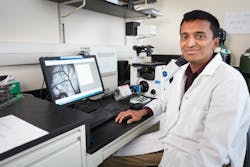The current standard of care is to treat head and neck cancer tumors with a seven-week regimen of radiation and chemotherapy. Follow-up clinical imaging using magnetic resonance imaging (MRI) and x-ray computed tomography (CT) is used eight weeks after treatment to determine whether a tumor has responded. However, this cancer treatment plan cannot identify how well the treatment is working during the process, according to Narasimhan Rajaram, assistant professor of biomedical engineering at the University of Arkansas (Fayetteville, AR).
Recognizing this, a grant from the National Institutes of Health (NIH; Bethesda, MD) will support Rajaram's pursuit of optical imaging technologies that can identify treatment-resistant tumors early in the treatment process. He has received a five-year, $2.03 million R01 grant from the National Cancer Institute (a part of NIH) to develop these technologies to help determine response to radiation and chemotherapy therapy during treatment of head and neck cancer. The goal is to help patients and physicians by monitoring treatment response during therapy and allowing changes to the treatment plan to more effectively treat patients.
"Unfortunately, there are currently no methods that can identify treatment response in the clinic during therapy, which causes patients—both responsive and resistant—to lose critical time when alternative approaches could be considered," Rajaram says.
Related: Raman spectroscopy helps distinguish tumors that resist radiation treatment
Rajaram's research team has partnered with researchers from Johns Hopkins University (Baltimore, MD) and the University of Arkansas for Medical Sciences (UAMS; Little Rock, AR) to conduct the research. Technology development and preclinical studies will be conducted at the University of Arkansas in Fayetteville and at Johns Hopkins, and clinical trials in patients will be conducted at UAMS. Rajaram's initial work in this area, to demonstrate the feasibility of the approach, was supported by startup funds from the University of Arkansas and the Arkansas Biosciences Institute.
The research will lead to the development of an endoscope-compatible fiber-optic probe that combines diffuse reflectance and Raman spectroscopy. Diffuse reflectance spectroscopy uses optical fibers to deliver low-power, non-ionizing visible light on tissue and collect the diffusely reflected light. The Rajaram lab has developed models of light-tissue interaction to extract meaningful quantitative information from this reflected light, such as tissue oxygenation. Raman spectroscopy is an optical fiber-based technique that uses a near-infrared laser to provide a highly specific fingerprint of molecules in tissue. Since every molecule has unique Raman features, mathematical models can be used to separately identify and quantify the contributions of individual molecules.
“These complementary tools can provide information about tumor oxygenation levels, which is critical for radiation therapy to work, as well as the contributions of key biomolecules in the tumor microenvironment that contribute to the development of radiation resistance,” Rajaram says.
Rajaram says that radiation is an important method for treating cancer, with most cancer patients receiving some form of radiation therapy to treat their cancers. Monitoring the effectiveness of that treatment can help doctors and patients make more informed decisions.
"For head and neck cancer specifically, the long treatment duration of seven weeks makes it imperative to find out right away if changes are required to the treatment regimen for non-responding tumors," Rajaram says. "Exceptional responders could also benefit by allowing potential de-escalation of the radiation dose."
The research is conducted by three teams with complementary expertise in optical imaging and radiation biology to develop a tool that can reveal key metabolic, functional, and molecular changes in cancer cells, Rajaram said. The combination of diffuse reflectance spectroscopy and Raman spectroscopy is designed to allow real-time monitoring of oxygen levels and metabolism in tumors, which can provide key indicators of treatment response.
What's more, Rajaram says the possibilities extend beyond just chemotherapy and radiation therapy: "There are new drugs constantly being developed to treat different cancers and such optical technologies could also be utilized to evaluate treatment outcomes sooner than currently possible."
For more information, please visit sites.uark.edu/nrajaram.
